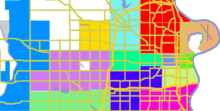Community areas

Omaha is split into several geographically designated areas, which cover several neighborhoods. Midtown is a racially diverse, historically rich area of Omaha immediately west of Downtown Omaha. North Omaha is a community area north of downtown Omaha with a rich historical, architectural, and religious legacy, particularly for the city's African American population. South Omaha is a community area encompassing many neighborhoods south of downtown Omaha which historically has been home to Omaha's Eastern European immigrant population, and more recently, Central and North American Hispanic immigrants. Churches and other structures reflect its rich past. Formerly a portion of this area was a separate city named South Omaha; it was annexed by Omaha in 1915. West Omaha is the collective term for areas of the city west of 72nd Street, and the area of newer suburbs and community institutions, the next wave of historically significant buildings. Within that broad area there are several sub-community areas including Northwest Omaha, Southwest Omaha, Millard and Irvington. Also, much further to the west is the newly annexed community area/past city of Elkhorn.
North Omaha
Scriptown was a conspicuous development first platted in 1855 to award Nebraska Territory legislators for the votes for statehood. It was bound by 16th street on the east, 24th on the west and Lake Street to the north. The area was developed quickly, and included a number of prominent homes. [6] The land therein formed the nucleus of Near North Omaha. Near North Omaha became one of the most historically significant communities in Omaha, as it developed commercially and socially into the 20th century. The area was bound by downtown Omaha on the south and the Saratoga neighborhood on the north, 30th Street on the west and 16th Avenue on the east. Created by historical German, Irish, Jewish, and African Americans, the community became a renowned center of Black culture in the United States in the 1920s. From then through the 1960s, the area was dominated by black-owned businesses, churches and social centers. There were also a number of Jewish-owned businesses, as well. The area was the site of several riots in the 1960s, and decayed for the next 30 years. The Great Plains Black History Museum was started there in 1976. Over the last 20 years a series of community restoration projects, including the demolition of the Logan Fontenelle Housing Projects and the creation of Dreamland Plaza, has sought to revitalize the community.
The Saratoga community is the location of a historical town that boomed and busted within one year of its founding. Its legacy includes a school, library and businesses still in the area. Also in the area is Kountze Place, a former suburban enclave of wealthy Omaha doctors, lawyers and businessmen. The northeast part of North Omaha, roughly defined by all areas north of Dodge Street and east of 16th Street, until Fort Street when Florence Boulevard becomes the western boundary. The eastern boundary is the Missouri River. Neighborhoods in this section of North Omaha include Carter Lake, Iowa, East Omaha and Beechwood. Carter Lake was formerly on the eastern side of the Missouri River. Originally part of the township of East Omaha, the community was ceded to the State of Iowa after a contentious court battle in the late 1890s. Omaha's Levi Carter Park is located here. Beechwood was located near Florence Lake in East Omaha. Located next to the Missouri River and the now-dry Florence Lake, Beechwood had its own school district and commercial area. Today it is site of a trailer court by the same name. East Omaha proper was once an agricultural area. Once considered for the site of the Trans-Mississippi Exposition, it lost out to Kountze Park. Omaha's main airport, Eppley Airfield, is now in East Omaha, and the community has been the location of racial contention for several years. East Omaha was the first annexation to the City of Omaha in 1854.
Far north Omaha includes everything north of Ames Avenue, west of Florence Boulevard, and east of 72nd Street. It includes Florence, the original Mormon settlement of Cutler's Park, which predates the founding of the City of Omaha; it was annexed in 1917. Miller Park, a neighborhood named after Omaha pioneer Dr. George Miller, was primarily developed from 1920 to 1950, bound by 30th Street on the west and Florence Blvd on the east, Miller Park on the north and Sorenson Parkway on the south. It is the location of several churches, an elementary school and a park by the same name. Minne Lusa is a neighborhood in far North Omaha primarily developed from 1915 and 1926, and bound by Miller Park on the south, Florence on the north, Florence Boulevard and Pershing Drive on the east, and 30th Street on the west. The southwest part of North Omaha includes Benson, located near 60th and Maple Streets. Originally incorporated as a city in the 1880s, it was annexed to Omaha in 1917. Benson has several historic locations, and is an important neighborhood today. Next to Benson is Dundee, near 50th and Dodge Streets. Originally a separate city, Dundee was annexed by Omaha in 1915, but this annexation was fought until 1917. The Gold Coast neighborhood, including St. Cecilia Cathedral, has several important architectural gems, as well as several historical parks. Other important historical neighborhoods in this area include Gifford Park, Orchard Hill and Walnut Hill.
